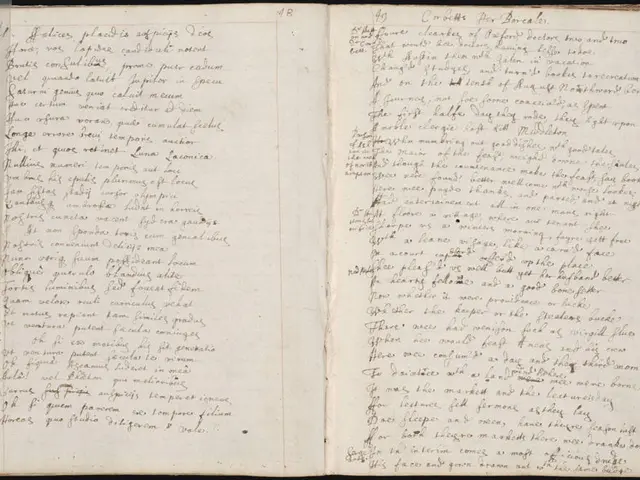Calcarea Carbonica: A Homeopathic Essential
Calcium Carbonate: A Common Mineral Used in Various Medical and Industrial Applications
Known as the cornerstone of homeopathic medicine, Calcarea Carbonica is a powerhouse remedy with profound impact. First introduced by the founder of homeopathy, Samuel Hahnemann, this remarkable remedy is frequently used due to its exceptional properties.
Often referred to as Calcarea or Calcium Carbonate (CaCO3) in homeopathic lingo, it is a versatile remedy with a broad spectrum of applications. It is ideally suited for individuals with a chalky complexion and specific physical and emotional characteristics.
Key Features and Indications:
Calcarea Carbonica, or Calc for short, is a polychrest remedy, meaning it has multiple applications. It is especially effective for folks who are overweight, flabby, yet physically weak. These folks often experience excessive sweating, even without heat, and have bones that are prone to weakness and deformation. They also tend to have tissues of substandard quality and quantity, appearing bulky and flabby. A persistent sense of fatigue and general weariness is common in these individuals, reflecting their overall weakened constitution.
- Origin and Natural Habitat
- Calcium Carbonate Composition
- Preparation Process
- Selective Interesting Facts
- Spheres of Action
- Bones
- Glands
- Blood
- Skin
- Mind
- Female Genital Organs
- Pathogenesis
- Constitution
- Key Characteristics
- Dosage and Guidelines
SOURCE INFORMATION
Origin and Natural Habitat
- Oyster Shell Source: The middle layer of the oyster shell is chosen for its high concentration of calcium carbonate.
- Oysters are marine mollusks that thrive in coastal regions, where they typically attach themselves to rocks or other hard surfaces in the ocean.
Calcium Carbonate Composition
- This mineral is essential for the oyster's shell structure, providing both strength and protection.
- The middle layer is selected because it represents the balance between the outer hard layer and the inner more flexible layer, embodying resilience and adaptability.
Preparation Process
- Collection: The oyster shells are carefully collected from their natural habitat. The middle layer, which contains the highest concentration of calcium carbonate, is extricated for use.
- Triturating: The collected material undergoes a trituration process, which involves grinding it to a fine powder.
- Diluting and Potentizing: The substance is systematically diluted and potentized according to homeopathic principles, which involve successive dilutions and vigorous shaking (succussion). This process enhances its therapeutic properties while eliminating toxic effects from the raw material.
Interesting Facts
- Symbolism of the Oyster Shell: The oyster shell's ability to create pearls from irritants parallels the remedy’s capability to help individuals transform stress and vulnerabilities into strength and resilience.
- Historical Use: Before its adoption in homeopathy, calcium carbonate from oyster shells has been used in traditional medicine for its soothing and healing properties.
SPHERES OF ACTION
Calc Carbonica primarily affects various systems in the body, including:
Bones
- Calc carbonicum has a strong influence on bone health and development, leading to issues like rickets in children and bone deformities such as bending of bones and delayed closure of fontanelles in infants.
Glands
- It impacts the glandular system, resulting in conditions such as swollen glands and the formation of abscesses within deep muscles.
Blood
- Calc carbonicum can affect the composition of blood, resulting in anemia or other blood disorders.
Skin
- This remedy influences the skin, often leading to increased sweating, particularly on the head and during sleep. It may also present as eczema, chronic skin conditions, or susceptibility to infections and inflammations.
Mind
- Calc carbonicum has significant effects on the mental and emotional state, causing symptoms like anxiety, apprehension, fearfulness, melancholy, forgetfulness, confusion, and timidity.
Female Genital Organs
- Calc carbonicum influences the female reproductive system, leading to menstrual irregularities and other gynecological problems.
Buy vitamins and supplements
PATHOGENESIS
The pathogenesis of Calc carbonicum involves impairment and metabolic disruptions affecting various organs, particularly the bones and skin.
Impairment in Nutrition
- Leads to deficiencies in calcium metabolism, which is vital for bone health and overall cellular functions, resulting in weakness in bones, poor development, and susceptibility to infections due to nutritional deficiencies.
Alteration in Blood Composition
- Causes changes in the blood’s makeup, leading to conditions like anemia and increased susceptibility to infections.
Increased Perspiration
- Causes excessive sweating, particularly on the head while sleeping, soaking the pillow.
Swelling of Glands
- Leads to swollen lymph nodes, thyroid issues, and frequent abscesses, particularly in muscles.
Softening and Bending of Bones
- Direct result of calcium deficiency and poor nutritional absorption, leading to conditions such as rickets in children, osteomalacia in adults, and other bone deformities.
Formation of Polypi and Exostoses
- Leads to benign growths like polyps and bone spurs.
CONSTITUTION
Calc carbonicum is ideal for individuals with a "leucophlegmatic" constitution, marked by pale and phlegmatic qualities.
Body Composition
- Typically, the leucophlegmatic individual is fair-skinned, fatty, and flabby, often appearing overweight even with poor muscle development.
- These individuals tend to be easily fatigued, especially on exertion, and may sweat profusely, particularly with a sour odor emanating from their body.
- They have a tendency towards obesity, especially in youth, and move slowly due to fatigue and lethargy.
Baby's Make-up
- Infants of leucophlegmatic individuals generally grow fat with a chalky appearance, a red face, and a large belly resembling an inverted saucer.
- They have large heads with open fontanelles and sutures, soft and pale skin, and underdeveloped bones.
- These babies are prone to sweating easily, especially on the back of the head and neck, and may experience swollen glands.
Relation with Heat and Cold
- Individuals with this constitution are generally chilly and prone to catching cold easily.
Miasm and Diathesis
- Calc carbonicum is considered one of the most effective remedies against Psoric and Sycotic conditions.
- It is well-suited for individuals with a scrofulous, rachitic, or tubercular diathesis.
KEY CHARACTERISTICS
Sensitive to Cold
- Tends to catch colds easily, often experiencing chronic coryza (nasal inflammation) linked to its psoric origin.
- Cannot tolerate cold, especially during acute stages (use Belladonna in such cases).
Tendency to Gain Weight
- Prone to becoming overweight, corpulent, and unwieldy.
Sweating
- Characteristic profuse sweating, particularly on the head while sleeping, soaking the pillow.
- Sweats mostly on the back of the head, neck, chest, and upper body.
- Sweat may be localized to specific parts like the head, scalp, neck, chest, armpits, sexual organs, hands, palms, knees, feet, soles, etc. Often with coldness and a sour smell, making feet raw from perspiration and leading to blisters and an offensive odor.
General Coldness
- Feels cold in general and in specific parts like the head, stomach, abdomen, feet, and legs, as if wearing cold, damp stockings.
- Continuously cold in bed and dislikes cold open air; sensitive to cold, damp air, and easily catches cold.
Constipation
- Feels better when constipated, requiring mechanical removal of stool (similar to Aloe, Sepia, Silicea, Thuja).
Polypi and Exostosis
- Effective remedy for growths like polyps and bone spurs.
Magnetism
- Desires to be magnetized (similar to Phosphorus and Silicea).
Sour Smelling Discharges
- All body discharges (vomit, diarrhea, sweat, eructations) have a sour smell; the whole body may have a sour odor (similar to Magnesia Carbonica, Hepar, Rheum).
Cravings and Aversions
- Strong craving for eggs, especially during illness or recovery.
- Desires indigestible things (similar to Alumina, Nitric acid, Cina, Cicuta, Psorinum).
- Aversion to meat (similar to Graphitis, Alumina, Pulsatilla, Muriatic acid).
- Longs for fresh air when indoors, which refreshes and strengthens them (similar to Pulsatilla, Sulphur).
Causes of Ailments
- Ailments may stem from poor nutrient absorption, incomplete bone formation, suppressed sweat, alcohol, cold moist wind, self-abuse, over-lifting, mental strain, loss of vital fluids, suppressed eruptions, suppressed menstruation, suppressed foot-sweat, or fright.
DETAILED ORGAN SYMPTOMS
PSYCHOLOGICAL PROFILE OF CALCAREA CARBONICA INDIVIDUAL
Dependency and Timidity
- Seeking Protection: Calcaria individuals have a strong need for security and protection from others. This need can manifest as an over-reliance on family, friends, or caregivers for support and guidance.
- Avoidance of Solitude: These individuals often avoid being alone, fearing isolation and the lack of a support system. This dependency reflects their underlying insecurity and fear of facing challenges independently.
- Timidity: A pronounced sense of timidity is evident, characterized by a pervasive sense of impending danger or evil. This fear can be irrational but deeply felt, leading to avoidance of new or unfamiliar situations.
Desire for Magnetization
- Need for Guidance: Individuals have a pronounced desire to be guided or controlled by others. This desire for direction helps them feel secure and reassured.
- Deferment in Medical Decisions: In medical settings, they often defer decision-making to healthcare providers, reflecting their dependency and desire for external validation and guidance.
Protective Shell and Avoidance of Risk
- Building a Protective Shell: To feel secure, these individuals construct a metaphorical protective shell around themselves, preferring familiar and safe environments where they can control variables.
- Avoiding Adventure and Risk: They tend to avoid adventurous or risky activities, seeking comfort in the known and familiar. They often surround themselves with individuals who provide a sense of protection and safety.
Intense Fears and Phobias
- Fear of Poverty, Pain, and Suffering: Calcaria individuals are plagued by intense fears, including fears of poverty, pain, and suffering. These fears can be debilitating and interfere with daily functioning.
- Specific Phobias: They may also have specific phobias, such as fear of fire or certain animals, particularly rats. These fears can be irrational but are deeply ingrained and challenging to overcome.
Indifference and Withdrawal
- Withdrawal When Unprotected: If they cannot find the protection they crave, they may become indifferent and withdrawn. This withdrawal serves as a defense mechanism against the perceived threats of the outside world.
- Engagement in Repetitive Activities: In their indifference, they might engage in repetitive or meaningless activities, providing a semblance of control and routine in their lives.
Response to Change and Loss of Security
- Significant changes in their environment or a loss of security, such as moving away from home or experiencing marital discord, can lead to feelings of being lost and unprotected.
- Heightened Vulnerability: These changes can heighten their sense of vulnerability and insecurity, making them more reliant on their coping mechanisms and support systems.
Fear and Apprehension
- Great Apprehension: Calcaria carb. individuals often experience significant anxiety and unease, particularly as the day progresses towards evening. This growing sense of dread can make nighttime particularly challenging.
- Specific Fears: They harbor deep fears of the dark, fearing the unknown and what it might conceal. They also worry about losing their sanity, facing misfortune, and developing chronic illnesses, reflecting a profound sense of vulnerability.
- Fear of Losing Control: There is a persistent anxiety about losing control over their thoughts and actions, coupled with a fear of being observed while in a state of confusion. This concern can lead to heightened self-consciousness and social anxiety.
Forgetfulness and Confusion
- Forgetfulness and Confusion: These individuals tend to be forgetful and often find themselves in a state of confusion. This mental cloudiness can interfere with daily activities and responsibilities.
- Melancholy: A pervasive sense of sadness and melancholy is common, often accompanied by palpitations and anxiety. This emotional state can lead to a diminished interest in life and activities once enjoyed.
Restlessness and Irritability
- Restless Mind: A restless and unsettled mind is typical, often resulting in a gloomy mood and persistent anxiety. The constant mental activity can be exhausting and overwhelming.
- Irritability and Obstinacy: They may become peevish, stubborn, and self-willed. This irritability is often coupled with a strong aversion to work and a general sense of dissatisfaction with life's demands.
Vulnerability and Coping Mechanisms
- Cowing: These individuals may weep, seek constant reassurance, or narrate their symptoms to others. This behavior is a plea for the support and protection they desperately need.
- Extreme Cases: In extreme cases, they may exhibit symptoms resembling other remedies like Stramonium or Rhus toxicodendron, depending on their coping strategies and life circumstances. This symptom overlap highlights the complexity of their psychological state and the need for careful, individualized treatment.
GASTROINTESTINAL TRACT
Mouth
- Sour Taste: The patient often experiences a sour taste in the mouth.
- Thirst: There is a significant thirst, especially in the afternoon.
- Toothache: The toothache occurs only while eating and is made worse by both hot and cold stimuli, and it tends to be more painful in the evening.
Stomach
- Swelling: The area at the pit of the stomach is swollen, resembling an inverted saucer, and is very painful when pressed.
- Cravings: There is a strong craving for non-food items like chalk, coal, pencil, and salt (similar to symptoms seen in conditions treated with Alumina, Cina, Cicuta, Nitric acid, and Psorinum).
- Desire for Eggs: The patient has a great longing for eggs, particularly during times of sickness or recovery.
- Aversion to Certain Foods: There is a dislike for meat, fat, and milk, which tend to disagree with the patient.
- Acidity: The digestive tract exhibits high acidity, leading to frequent sour burps, vomiting, and stools.
Abdomen
- Pot-Bellied: The abdomen appears swollen and rounded, like a pot-belly, and is very sensitive to even slight pressure.
Stool
- Constipation: The patient usually suffers from constipation and feels better in general when constipated.
- Occasional Diarrhea: There may be occasional bouts of diarrhea, especially in children during teething periods.
- Stool Characteristics: The stool is often white and has a sour smell.
RESPIRATORY SYSTEM
Nose
- Symptoms: Frequent sneezing without a cold, and dry nasal passages with much sneezing.
Throat
- Pain: Stitching pain in the throat during swallowing.
- Uvula: Dark red with vesicles.
Cough
- Dry and tickling, occurring in single paroxysms.
Bronchial Asthma
- Severe anxious asthma with difficulty breathing (dyspnoea) and stitching pains in the chest. Tension in the lower chest, hot breath, and heat in the mouth but no thirst.
Tuberculosis
- Effective in pretubercular conditions and for tubercular lung affections in tall, slender, rapidly growing young people. Typically affects the upper third of the right lung.
FEMALE SYMPTOMS
Menses
- Calcaria carbonica is an excellent remedy for menstrual troubles, such as:
- Starting too early
- Excessive flow
- Long duration
- Scanty or suppressed flow
- Bright red blood during the flow
- Profuse flow induced even by the least mental excitement
Timing
- Before menstruation:
- Chills in the evening and colic throughout the night
- Voluptuous dreams
- Headaches the day before menstruation, accompanied by chills in the evening and colic throughout the night
- During menstruation:
- Vertigo with a rush of blood to the head and heat on the top of the head (vertex)
- Nausea, sometimes with vomiting
- Tenesmus (a feeling of needing to pass stools or urine)
After Menstruation
- Pinching colic once menstruation ceases
Leucorrhoea
- women requiring this remedy may also experience milky white but acrid leucorrhoea (vaginal discharge)
Common Female Symptoms
- Late dentition and walking
- Delayed ossification (slow bone development)
- Weak bones resulting in curvatures and deformities
- Sequelae of gonorrhea and syphilis
BONE SYMPTOMS
- Calcaria carbonica exhibits notable bone symptoms, especially in rickety children:
- Bone weakness and slow development
- Unable to support weight due to fatty tissue
- Curvatures in bones, especially in the spine and long bones, leading to crooked and deformed extremities
- Late walking due to weak bones
- Teeth emerge late, leading to difficult and delayed dentition
Caries of Vertebrae
- Calcaria carbonica is deemed superior in treating caries of the vertebrae.
Specific Cases
- The elderly suffering from fatty degeneration of the heart, experiencing palpitation and dyspnea with minimal exertion.
- Young men with rapid growth and tubercular infiltration, especially in the upper lobe of the right lung.
- Young girls experiencing rapid growth, leading to anemia and chlorosis.
BABY
Physical Characteristics
- Fair complexion, with a fatty and flabby build.
- Red face and flabby muscles.
- Large head and a swollen abdomen that resembles an inverted saucer.
Skeletal Development
- Bones develop slowly and are weak.
- Fontanelles and sutures on the skull remain open for an extended period, indicating delayed ossification.
- Curvatures are observed in bones, particularly in the spine and long bones, leading to crooked and deformed extremities.
- Late walking and teeth eruption due to slow bone development.
Gastrointestinal Symptoms
- Tendency towards constipation, but may experience sour, offensive diarrhea during teething, accompanied by sour vomiting.
- Body and excretions emit a sour odor.
Developmental Milestones
- Delayed milestones, such as walking and tooth eruption.
Mental and Emotional Characteristics
- Mental deficiency and appearance of some intellectual disability.
Sweating Pattern
- Sweats profusely, especially on the back of the head, neck, chest, and upper body, notably during sleep, wetting the pillow.
Health Susceptibility
- Prone to colds and has a predisposition to tuberculosis, with enlarged glands.
Desire for Magnetization
- Shows a desire to be magnetized, similar to the symptom observed in individuals requiring Phosphorus.
WHAT ARE MODALITIES IN HOMOEOPATHY?
RELATION WITH OTHER DRUGS
Antidotes
- Bismuth, Digitalis (Dig.), Nitric acid, Nux vomica (Nux.), Sulphur
Antidoted by
- Acetic acid, China, Nitric acid, Camphor, Ipecacuanha (Ipec.)
Complementary Remedies
- Belladonna: Calcaria is the chronic of Belladonna and complements it. However, Belladonna should not be used before Sulphur.
- Sulphur: Calcaria acts best after Sulphur and should not be used before it.
Repetition Guidelines
- Calcaria should not be repeated frequently. In children, it can be repeated in low potency.
Followed Well By
- Lycopodium (Lyc.), Nux vomica (Nux.), Phosphorus (Phos.), Platinum (Plat.), Silicea (Sil.)
Follows Well
- Chamomilla (Cham.), Conium (Con.), Cuprum (Cup.), Nitric acid (Nit. ac.), Nux vomica (Nux.), Pulsatilla (Puls.), Sulphur.
Incompatible: Bryonia (Bry.)
Comparative Remedies
- Lime-Water (Aqua Calcar.): Used in milk as an injection for oxyuris vermicularis.
- Slaked Lime (Calc. Caust.): For pain in back, heels, jaws, and malar bones; symptoms of influenza.
- Calcium Bromide (Calc. Brom.): For removing inflammatory products from the uterus, especially in nervous and irritable children with gastric and cerebral irritation, and insomnia.
- Calcined Oyster-Shell (Calcar. Calcinata): For warts.
- Calcium Lactate (Calcar. Lactic.): For anaemia, haemophilia, urticaria, nervous headache with oedema of eyelids, lips, or hands.
- Calcium Lacto-Phosphate (Calc. Lacto-Phosph.): Used in cyclic vomiting and migraines.
- Calcium Chloride (Calc. Mur.): For boils, vomiting of all food and drink with gastric pain, impetigo, glandular swellings, and eczema in infants.
- Calcium Picrate (Calc. Picrata): For chronic boils, sty, and dry scurfy accumulation on parts thinly covered with muscle tissue.
HOMOEOPATHIC POTENCIES AND DOSAGE GUIDELINES
- Calcarea Carbonica is administered in various potencies, each tailored to the individual's needs and the specific symptoms presented.
- The most common potencies used are the sixth trituration (6X), thirtieth potency (30C), and higher potencies.
Special Considerations for Elderly Patients
- In elderly patients, Calcarea Carbonica should not be repeated too frequently. Older individuals often have a slower response to remedies and are more sensitive to their effects.
- For elderly patients, starting with lower potencies and gradually increasing, if necessary, is advisable. This cautious approach helps avoid any undue aggravation of symptoms.
- Regular follow-up and careful monitoring are essential to adjust the dosage and frequency based on the patient’s response and improvement.
- Calcarea Carbonica, as a versatile remedy, is especially effective for individuals with a weakened constitution, characterized by excessive sweating, weak bones that can be prone to deformities, and a persistent sense of fatigue.
- In the realm of health and wellness, Calcarea Carbonica plays a significant role in the treatment of breast cancer, both in terms of its pathogenesis and therapeutic action on the female genital organs.
- The polychrest remedy Calcarea Carbonica exhibits profound effects on the female reproductive system, leading to menstrual irregularities and other gynecological issues, including a risk of developing breast cancer.








